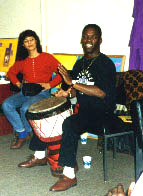|
Master Drummer Mamady Keita
In 1957, Mamady was initiated into the secrets of the djembe and to the history of his people, the Mandingue. In 1963, he was taken to perform in the regional ballet, about 150 km from his home and in 1964, he was taken 2000 km away to the capital city Conakry where the President of Guinea, Sekou Touré, was working with Harry Belafonte to produce the National Ballet of Guinea, Ballet National Djoliba. He was one of 50 percussionists who auditioned during 9 months of training and in the end was one of the final 5 who made it into the Ballet. At only 14 years of age, Mamady was by far the youngest member of the National Ballet. That same year he starred in the Harry Belafonte film, Africa Dance. Mamady remained in the National Ballet until 1986, during which time he won gold medals in many International and Pan-African Festivals and was also named Best African Drummer. He went on to become the djembe soloist and lead drummer of Ballet Djoliba and in 1979 was named as Artistic Director. He created many of the musical repertoires used in the Ballets and trained many of the worlds top djembe players. In 1986, Mamady decided to make his personal mark in the world by breaking out of the Ballet and establishing himself as an independent drummer. He moved to the Ivory Coast where he joined Souleymane Kolis group Koteba and performed next to such renowned African stars as Touré Kunda of Senegal, and Mory Kante of Guinea. During his stay in Ivory Coast, Mamady starred in another movie, titled La Vie Platinée, and also wrote and recorded the entire sound track.. When Mamadys name began to travel beyond West Africa, a group of percussionists in Belgium decided to bring him into Europe to teach and perform. That happened in 1988 with a non-profit organization called Zig-Zag. In cooperation, Mamady helped open a school of percussion which they called Repercussions, and later that same year, Mamady established his own performance ensemble, Sewa Kan. The name refers to a Malinke proverb which says Without music there is no joy, but without joy there is no music. In 1991, Mamady decided it was time to go his own way and he established his own percussion school which he called Tam Tam Mandingue, drums of the Manding. Over the 13 years that bring us up to the present year 2004, Mamady produced 9 cds, 6 instructional video/dvds, a book (Mamady Keita: A Life For the Djembe), several documentary films (including internationally acclaimed Djembefola, by Laurent Chevalier), and extended his percussion school to include 18 branches across the globe (France, Germany, Switzerland, Spain, Belgium, Japan, USA, Israel). Each year Mamady travels to these countries for one to three months at a time to teach workshops and perform with Sewa Kan. Mamady also brings students to Guinea every winter to participate in a 3 week drum camp at his house in Conakry. He currently resides in Belgium, but will be relocating to San Diego, California in September of 2004. The following is a complete list of Mamady Keitas cds: Wassolon, Nankama, Mogobalu, Hamana, Afo, Balandugukan, Mamady Lee, A Giate , Sila Laka (will be released in September 2004).
|
